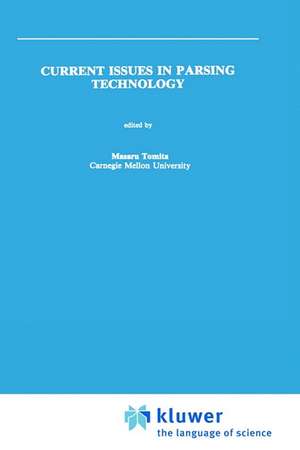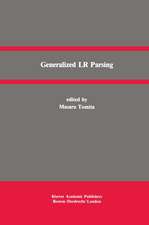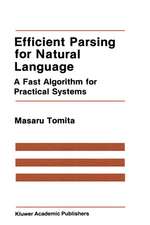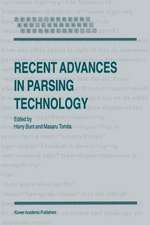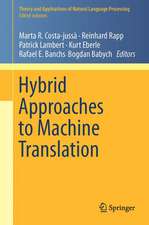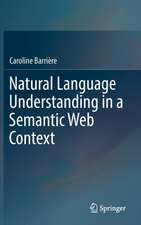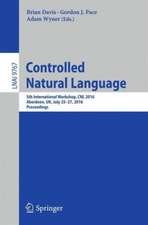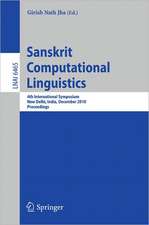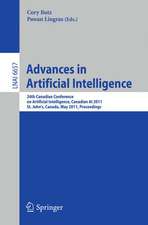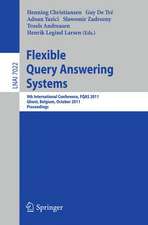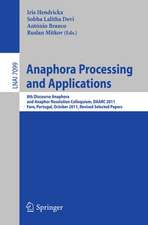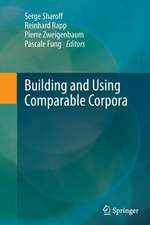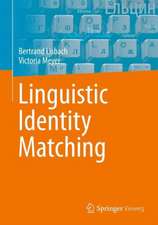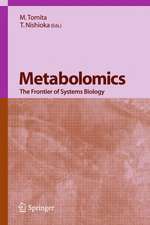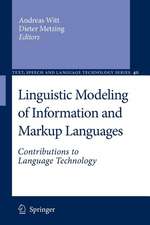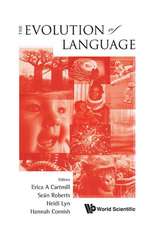Current Issues in Parsing Technology: The Springer International Series in Engineering and Computer Science, cartea 126
Editat de Masaru Tomitaen Limba Engleză Hardback – 31 dec 1990
| Toate formatele și edițiile | Preț | Express |
|---|---|---|
| Paperback (1) | 1272.94 lei 6-8 săpt. | |
| Springer Us – 12 oct 2012 | 1272.94 lei 6-8 săpt. | |
| Hardback (1) | 1279.34 lei 6-8 săpt. | |
| Springer Us – 31 dec 1990 | 1279.34 lei 6-8 săpt. |
Din seria The Springer International Series in Engineering and Computer Science
- 24%
 Preț: 1041.98 lei
Preț: 1041.98 lei - 20%
 Preț: 643.50 lei
Preț: 643.50 lei - 18%
 Preț: 1225.62 lei
Preț: 1225.62 lei - 18%
 Preț: 965.02 lei
Preț: 965.02 lei - 20%
 Preț: 646.12 lei
Preț: 646.12 lei - 18%
 Preț: 948.79 lei
Preț: 948.79 lei - 20%
 Preț: 646.62 lei
Preț: 646.62 lei - 15%
 Preț: 637.46 lei
Preț: 637.46 lei - 20%
 Preț: 643.83 lei
Preț: 643.83 lei - 18%
 Preț: 949.23 lei
Preț: 949.23 lei - 20%
 Preț: 644.48 lei
Preț: 644.48 lei - 20%
 Preț: 994.92 lei
Preț: 994.92 lei - 20%
 Preț: 645.97 lei
Preț: 645.97 lei - 18%
 Preț: 946.87 lei
Preț: 946.87 lei - 20%
 Preț: 995.57 lei
Preț: 995.57 lei - 18%
 Preț: 956.99 lei
Preț: 956.99 lei - 20%
 Preț: 644.98 lei
Preț: 644.98 lei - 15%
 Preț: 649.54 lei
Preț: 649.54 lei - 18%
 Preț: 950.21 lei
Preț: 950.21 lei - 18%
 Preț: 1221.38 lei
Preț: 1221.38 lei - 18%
 Preț: 957.62 lei
Preț: 957.62 lei - 15%
 Preț: 643.99 lei
Preț: 643.99 lei - 18%
 Preț: 948.47 lei
Preț: 948.47 lei - 18%
 Preț: 947.35 lei
Preț: 947.35 lei - 20%
 Preț: 1284.65 lei
Preț: 1284.65 lei - 20%
 Preț: 1628.31 lei
Preț: 1628.31 lei - 20%
 Preț: 1285.78 lei
Preț: 1285.78 lei
Preț: 1279.34 lei
Preț vechi: 1599.17 lei
-20% Nou
Puncte Express: 1919
Preț estimativ în valută:
244.83€ • 265.85$ • 205.66£
244.83€ • 265.85$ • 205.66£
Carte tipărită la comandă
Livrare economică 22 aprilie-06 mai
Preluare comenzi: 021 569.72.76
Specificații
ISBN-13: 9780792391319
ISBN-10: 0792391314
Pagini: 297
Ilustrații: XXI, 297 p.
Dimensiuni: 155 x 235 x 19 mm
Greutate: 0.63 kg
Ediția:1991
Editura: Springer Us
Colecția Springer
Seria The Springer International Series in Engineering and Computer Science
Locul publicării:New York, NY, United States
ISBN-10: 0792391314
Pagini: 297
Ilustrații: XXI, 297 p.
Dimensiuni: 155 x 235 x 19 mm
Greutate: 0.63 kg
Ediția:1991
Editura: Springer Us
Colecția Springer
Seria The Springer International Series in Engineering and Computer Science
Locul publicării:New York, NY, United States
Public țintă
ResearchCuprins
1 Why Parsing Technologies?.- 1.1 The gap between theory and application.- 1.2 About this book.- 2 The Computational Implementation of Principle-Based Parsers.- 2.1 Introduction.- 2.2 The principle ordering problem.- 2.3 Examples of parsing using the Po-Parser.- 2.4 Concluding remarks.- 3 Parsing with Lexicalized Tree Adjoining Grammar.- 3.1 Introduction.- 3.2 Lexicalization of CFGs.- 3.3 Lexicalized TAGs.- 3.4 Parsing lexicalized TAGs.- 3.5 Concluding remarks.- 4 Parsing with Discontinuous Phrase Structure Grammar.- 4.1 Introduction.- 4.2 Trees with discontinuities.- 4.3 Disco-Trees in grammar rules.- 4.4 Implementing DPSG: An enhanced chart parser.- 4.5 Concluding remarks.- 5 Parsing with Categorial Grammar in Predictive Normal Form.- 5.1 Introduction.- 5.2 Overview of predictive normal form.- 5.3 Source grammar (G).- 5.4 Predictive normal form (G).- 5.5 Ambiguity in G.- 5.6 Equivalence of G and G.- 5.7 Concluding remarks.- 6 PREMO: Parsing by conspicuous lexical consumption.- 6.1 Introduction.- 6.2 The preference machine.- 6.3 Global data.- 6.4 Preference semantics.- 6.5 PREMO example.- 6.6 Comparison to other work.- 6.7 Concluding remarks.- 7 Parsing, Word Associations, and Typical Predicate-Argument Relations.- 7.1 Mutual information.- 7.2 Phrasal verbs.- 7.3 Preprocessing the corpus with a part of speech tagger.- 7.4 Preprocessing with a syntactic parser.- 7.5 Significance levels.- 7.6 Just a powerful tool.- 7.7 Practical applications.- 7.8 Alternatives to collocation for recognition applications.- 7.9 Concluding remarks.- 8 Parsing Spoken Language Using Combinatory Grammars.- 8.1 Introduction.- 8.2 Structure and intonation.- 8.3 Combinatory grammars.- 8.4 Parsing with CCG.- 8.5 Intonational structure.- 8.6 A hypothesis.- 8.7 Conclusion.- 9 A Dependency-Based Parser for Topic and Focus.- 9.1 Introduction.- 9.2 Dependency-based output structures.- 9.3 The semantic impact of topic-focus articulation.- 9.4 Parsing procedure for topic and focus.- 9.5 Parsing sentences in a text.- 9.6 Concluding remarks.- 10 A Probabilistic Parsing Method for Sentence Disambiguation.- 10.1 Introduction.- 10.2 Probabilistic context-free grammar.- 10.3 Experiments.- 10.4 Concluding remarks.- 11 Towards a Uniform Formal Framework for Parsing.- 11.1 Introduction.- 11.2 Context-free parsing.- 11.3 Horn clauses.- 11.4 Other linguistic formalisms.- 11.5 Concluding remarks.- 12 A Method for Disjunctive Constraint Satisfaction.- 12.1 Introduction.- 12.2 Turning disjunctions into contexted constraints.- 12.3 Normalizing the contexted constraints.- 12.4 Extracting the disjunctive residue.- 12.5 Producing the models.- 12.6 Comparison with other techniques.- 12.7 Concluding remarks.- 13 Polynomial Parsing of Extensions of Context-Free Grammars.- 13.1 Introduction.- 13.2 Linear indexed grammars.- 13.3 Combinatory categorial grammars.- 13.4 Tree Adjoining Grammars.- 13.5 Importance of linearity.- 13.6 Concluding remarks.- 14 Overview of Parallel Parsing Strategies.- 14.1 Introduction.- 14.2 From one to many traditional serial parsers.- 14.3 Translating grammar rules into process configurations.- 14.4 From sentence words to processes.- 14.5 Connectionist parsing algorithms.- 14.6 Concluding remarks.- 15 Chart Parsing for Loosely Coupled Parallel Systems.- 15.1 Introduction.- 15.2 Parsing for loosely coupled systems.- 15.3 Parallelism and the chart.- 15.4 Distributing the chart.- 15.5 Communication vs. computation — Results for the Hypercube™.- 15.6 Towards wider comparability — The abstract parallel agenda.- 15.7 Termination and Synchronization.- 15.8 Testingthe portable system — Results of network experiment.- 15.9 Alternative patterns of edge distribution.- 15.10 Concluding remarks.- 16 Parsing with Connectionist Networks.- 16.1 Introduction.- 16.2 Incremental parsing.- 16.3 Connectionist network formalism.- 16.4 Parsing network architecture.- 16.5 Parsing network performance.- 16.6 Extensions.- 16.7 Concluding remarks.- 17 A Broad-Coverage Natural Language Analysis System.- 17.1 Introduction.- 17.2 A syntactic sketch: PEG.- 17.3 Semantic readjustment.- 17.4 The paragraph as a discourse unit.- 17.5 Concluding remarks.- 18 Parsing 2-Dimensional Language.- 18.1 Introduction.- 18.2 The 2D-Earley parsing algorithm.- 18.3 The 2D-LR parsing algorithm.- 18.4 More interesting 2D grammars.- 18.5 Formal property of 2D-CFG.- 18.6 Concluding remarks.
